|
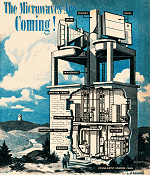 Decades ago, every issue of Popular
Science magazine was cram-packed with information on just about every subject.
Most of it was presented in news tidbit format with an image and a short description.
Some stories got a full page, and others, like this one entitled, "The
Microwaves Are Coming," rated a multi-page spread. Unlike today's communications
systems where microwaves are ubiquitous, in 1949, the technology was relatively
new, having had its materials and methods greatly advanced during the war years.
Coaxial cable's use in high frequency communications was ramping up at the same
time. The Bell Telephone Company and Radio Corporation of America (RCA) were key
players in designing, installing, and operating microwave systems for use in telephony,
facsimile messaging, television, telegrams, radio mail (early e-mail), and other
services. Western Civilization that enabled the innovation and implementation of
such things is today used by agitators and terrorists to rail against Western
Civilization, whilst their ancestral lands still mire in thatch huts and engage
in human slavery... Decades ago, every issue of Popular
Science magazine was cram-packed with information on just about every subject.
Most of it was presented in news tidbit format with an image and a short description.
Some stories got a full page, and others, like this one entitled, "The
Microwaves Are Coming," rated a multi-page spread. Unlike today's communications
systems where microwaves are ubiquitous, in 1949, the technology was relatively
new, having had its materials and methods greatly advanced during the war years.
Coaxial cable's use in high frequency communications was ramping up at the same
time. The Bell Telephone Company and Radio Corporation of America (RCA) were key
players in designing, installing, and operating microwave systems for use in telephony,
facsimile messaging, television, telegrams, radio mail (early e-mail), and other
services. Western Civilization that enabled the innovation and implementation of
such things is today used by agitators and terrorists to rail against Western
Civilization, whilst their ancestral lands still mire in thatch huts and engage
in human slavery...
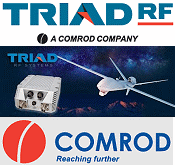 COMROD Communication AS (COMROD), has acquired
a majority share of
Triad RF Systems Inc. (Triad). The East Brunswick, New Jersey, USA company is
an innovative designer and manufacturer of RF/Microwave amplifiers and integrated
radio solutions for long-range RF communication in challenging environments including
defense applications and aerospace systems. The acquisition of Triad further positions
COMROD as a premier radio ancillary manufacturer that helps customers reach further
with cutting-edge technology. In addition to strengthening COMROD's RF capability
and capacity, the combined companies will be able to cooperate on next-generation
Radio Range Extension solutions. Triad's constant push to extend the limits of data
and distance... COMROD Communication AS (COMROD), has acquired
a majority share of
Triad RF Systems Inc. (Triad). The East Brunswick, New Jersey, USA company is
an innovative designer and manufacturer of RF/Microwave amplifiers and integrated
radio solutions for long-range RF communication in challenging environments including
defense applications and aerospace systems. The acquisition of Triad further positions
COMROD as a premier radio ancillary manufacturer that helps customers reach further
with cutting-edge technology. In addition to strengthening COMROD's RF capability
and capacity, the combined companies will be able to cooperate on next-generation
Radio Range Extension solutions. Triad's constant push to extend the limits of data
and distance...
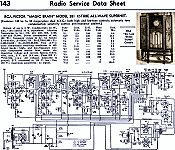 This Radio Service Data Sheet which appeared
in a 1935 issue of Radio-Craft provides schematics and parts lists for
RCA-Victor "Magic Brain" Model 281, 12-Tube All-Wave Superheterodyne receivers.
Most - if not all - electronics servicemen had subscriptions to these magazines
because they were a ready source of not just these service sheets, but because of
the extensive articles offering advice on servicing radios and televisions. In fact,
many electronics manufacturers had a policy of supplying service data only to bona
fide shops. A large list is included at the bottom of the page of similar documents
from vintage receiver schematics, troubleshooting tips, and alignment procedures... This Radio Service Data Sheet which appeared
in a 1935 issue of Radio-Craft provides schematics and parts lists for
RCA-Victor "Magic Brain" Model 281, 12-Tube All-Wave Superheterodyne receivers.
Most - if not all - electronics servicemen had subscriptions to these magazines
because they were a ready source of not just these service sheets, but because of
the extensive articles offering advice on servicing radios and televisions. In fact,
many electronics manufacturers had a policy of supplying service data only to bona
fide shops. A large list is included at the bottom of the page of similar documents
from vintage receiver schematics, troubleshooting tips, and alignment procedures...
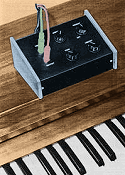 An RF Cafe visitor wrote to ask that I scan
and post this article on the
Leslie Effect Simulator, which appeared in a 1965 issue of Popular Electronics
magazine. "What the heck is the Leslie effect?" you are probably asking, as did
I. Basically, it is a mechanism for artificially creating the "wobbulating" effect
of a pipe organ in a large echoing environment. Inventor Donald Leslie worked for
the Hammond organ company and developed an electromechanical contraption that rotated
a baffle in front of speakers to create the effect. Commercial electronic Leslie
Effect products were sold back in the 1960s and 1970s when high fidelity (hifi)
stereo equipment was the "in" thing, like computers were in the 1990s and cellphones
are now. There were a lot of electronics hobbyists that loved to build projects
printed in magazines like Popular Electronics, especially since at the time many
things could be built more cheaply than buying a finished product off the store
shelf. Electric guitar players were big adopters of Leslie effect generators, and
were used by lots of top musicians. You can buy some of the vintage devices... An RF Cafe visitor wrote to ask that I scan
and post this article on the
Leslie Effect Simulator, which appeared in a 1965 issue of Popular Electronics
magazine. "What the heck is the Leslie effect?" you are probably asking, as did
I. Basically, it is a mechanism for artificially creating the "wobbulating" effect
of a pipe organ in a large echoing environment. Inventor Donald Leslie worked for
the Hammond organ company and developed an electromechanical contraption that rotated
a baffle in front of speakers to create the effect. Commercial electronic Leslie
Effect products were sold back in the 1960s and 1970s when high fidelity (hifi)
stereo equipment was the "in" thing, like computers were in the 1990s and cellphones
are now. There were a lot of electronics hobbyists that loved to build projects
printed in magazines like Popular Electronics, especially since at the time many
things could be built more cheaply than buying a finished product off the store
shelf. Electric guitar players were big adopters of Leslie effect generators, and
were used by lots of top musicians. You can buy some of the vintage devices...
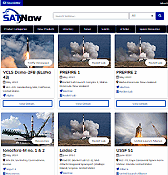 As a lifelong model rocketeer, I have always
been fascinated with watching rocket launches - whether full size or miniatures.
The SATNow website has an
aggregator page that reports upcoming launches of satellite-bearing rockets (and
keeps a history of past launches). These include NASA, Space X, Rocket, ISRO, Blue
Origin, and many more. The launch date, location (worldwide) and vehicle used are
provided for upcoming launches that have been publicly announced. Example for
VCLS Demo-2FB (ELaNa 43), Vandenberg SFB, CA, U.S.: "Firefly was selected by
NASA to provide launches services as part of our Venture Class Launch Services Demonstration
2 (VCLS Demo 2) contract. These launches can tolerate a higher level of risk than
larger missions, and they help demonstrate the capabilities of launch vehicles like
Alpha that support a new launch class and provide more access to space for small
satellites and spacecraft..." As a lifelong model rocketeer, I have always
been fascinated with watching rocket launches - whether full size or miniatures.
The SATNow website has an
aggregator page that reports upcoming launches of satellite-bearing rockets (and
keeps a history of past launches). These include NASA, Space X, Rocket, ISRO, Blue
Origin, and many more. The launch date, location (worldwide) and vehicle used are
provided for upcoming launches that have been publicly announced. Example for
VCLS Demo-2FB (ELaNa 43), Vandenberg SFB, CA, U.S.: "Firefly was selected by
NASA to provide launches services as part of our Venture Class Launch Services Demonstration
2 (VCLS Demo 2) contract. These launches can tolerate a higher level of risk than
larger missions, and they help demonstrate the capabilities of launch vehicles like
Alpha that support a new launch class and provide more access to space for small
satellites and spacecraft..."
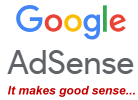 One aspect of advertising on the RF Cafe
website I have not covered is using
Google AdSense.
The reason is that I never took the time to explore how - or even whether it is
possible - to target a specific website for displaying your banner ads. A couple
display opportunities have always been provided for Google Ads to display, but the
vast majority of advertising on RF Cafe is done via private advertisers. That is,
companies deal with me directly and I handle inserting their banner ads into the
html page code that randomly selects and displays them. My advertising scheme is
what the industry refers to as a "Tenancy Campaign," whereby a flat price per month
is paid regardless of number of impressions or clicks. It is the simplest format
and has seemed to work well for many companies. With nearly 4 million pageviews
per year for RFCafe.com, the average impression rate per banner ad is about 280k
per year (in eight locations on each page, with >17k pages)... One aspect of advertising on the RF Cafe
website I have not covered is using
Google AdSense.
The reason is that I never took the time to explore how - or even whether it is
possible - to target a specific website for displaying your banner ads. A couple
display opportunities have always been provided for Google Ads to display, but the
vast majority of advertising on RF Cafe is done via private advertisers. That is,
companies deal with me directly and I handle inserting their banner ads into the
html page code that randomly selects and displays them. My advertising scheme is
what the industry refers to as a "Tenancy Campaign," whereby a flat price per month
is paid regardless of number of impressions or clicks. It is the simplest format
and has seemed to work well for many companies. With nearly 4 million pageviews
per year for RFCafe.com, the average impression rate per banner ad is about 280k
per year (in eight locations on each page, with >17k pages)...
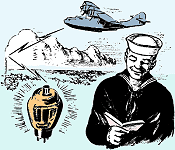 In an electrical system, "how much?" is
asked about four quantities - current, voltage, resistance, and power. And four
kinds of
meters measure these quantities - ammeters, voltmeters, ohmmeters, and wattmeters.
Each meter's name indicates its use. Every conductor, every motor, every circuit
of any kind has a rated current load. Exceed this rated load and you ask for trouble
- heat develops, connections melt, and insulation burns. Ammeters tell you exactly
how much current is flowing - they forewarn you of overload. Each insulation has
a voltage rating. And 120-volt insulation will not stand 240 volts. It's like trying
to put 70 pounds of air pressure in a bicycle tire rated at 35 pounds. Something
lets loose. Motors are built to operate at a definite voltage of 110, 220, or 440
volts. If you try to operate a motor above or below its rated voltage, it either
"burns out" or gives such poor service that it's useless... In an electrical system, "how much?" is
asked about four quantities - current, voltage, resistance, and power. And four
kinds of
meters measure these quantities - ammeters, voltmeters, ohmmeters, and wattmeters.
Each meter's name indicates its use. Every conductor, every motor, every circuit
of any kind has a rated current load. Exceed this rated load and you ask for trouble
- heat develops, connections melt, and insulation burns. Ammeters tell you exactly
how much current is flowing - they forewarn you of overload. Each insulation has
a voltage rating. And 120-volt insulation will not stand 240 volts. It's like trying
to put 70 pounds of air pressure in a bicycle tire rated at 35 pounds. Something
lets loose. Motors are built to operate at a definite voltage of 110, 220, or 440
volts. If you try to operate a motor above or below its rated voltage, it either
"burns out" or gives such poor service that it's useless...
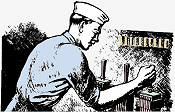 During the late 1700's and early 1800's,
three great electrical discoveries were made. An Italian, named Volta, discovered
how to produce an EMF from a primary cell. He gave his name to the measuring unit
of electromotive force - the VOLT. Ampere, a Frenchman, measured current flaw and
gave his name to the measuring unit of current - the AMPERE. A German, named Ohm,
measured the resistance of circuits and conductors and gave his name to the resistance
measuring unit - the OHM. Ohm did more than experiment with resistance - he connected
his own discoveries with those of Volta and Ampere. The result was
OHM'S LAW. Make sure you understand each one of the three quantities in electricity
- they make up Ohm's Law. On the following page is a table of these important quantities,
their symbols, their units, their abbreviations, and their effects an a circuit... During the late 1700's and early 1800's,
three great electrical discoveries were made. An Italian, named Volta, discovered
how to produce an EMF from a primary cell. He gave his name to the measuring unit
of electromotive force - the VOLT. Ampere, a Frenchman, measured current flaw and
gave his name to the measuring unit of current - the AMPERE. A German, named Ohm,
measured the resistance of circuits and conductors and gave his name to the resistance
measuring unit - the OHM. Ohm did more than experiment with resistance - he connected
his own discoveries with those of Volta and Ampere. The result was
OHM'S LAW. Make sure you understand each one of the three quantities in electricity
- they make up Ohm's Law. On the following page is a table of these important quantities,
their symbols, their units, their abbreviations, and their effects an a circuit...
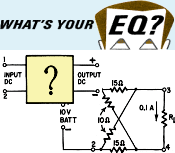 This newest "What's
Your EQ?" (Electronics Quotient) challenge appeared in the April 1967 issue
of Radio-Electronics magazine. It only has two circuits to work out. The first is
a fairly basic analysis problem where a voltage source and some resistors are connected.
You need to solve for the value of one resistor, given the current through it. As
it often the case, re-drawing the schematic to remove cross-connections clarifies
the situation and makes the task much simpler. The other problem is a black box
type, and it should not pose much of a problem. Not stated but implied is that the
diodes within are ideal and do not have a junction voltage drop (sorry for the spoiler,
but it really should have been included in the statement). Bon chance, viel Glück,
祝你好运, buena suerte, Удачи, καλή τύχη, がんばって, powodzenia, buona fortuna, and good
luck... This newest "What's
Your EQ?" (Electronics Quotient) challenge appeared in the April 1967 issue
of Radio-Electronics magazine. It only has two circuits to work out. The first is
a fairly basic analysis problem where a voltage source and some resistors are connected.
You need to solve for the value of one resistor, given the current through it. As
it often the case, re-drawing the schematic to remove cross-connections clarifies
the situation and makes the task much simpler. The other problem is a black box
type, and it should not pose much of a problem. Not stated but implied is that the
diodes within are ideal and do not have a junction voltage drop (sorry for the spoiler,
but it really should have been included in the statement). Bon chance, viel Glück,
祝你好运, buena suerte, Удачи, καλή τύχη, がんばって, powodzenia, buona fortuna, and good
luck...
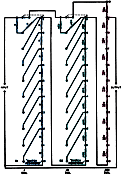 It took me a couple passes of the explanation
to comprehend the advantage of a Thomson-Varley (aka Kelvin-Varley, since Thomson
and Lord Kelvin are one and the same person)
switchable voltage divider compared to a standard type. At first I thought the
author, Edwin Bohr, was implying that the source and load impedances would not have
as great of an effect on the accuracy of the divider (and to some extent it is less
sensitive), but the main advantage is that the configuration permits simple cascading
stages of decade dividers to achieve essentially any degree of resolution. Both
a standard series-wired type voltage divider and the Thomson-Varley need ten resistors
and eleven switch positions to provide 10 equal steps (plus bypass). However, using
the same approach for 100 equal steps in the standard divider scheme would require
100 resistors, 1000 steps would require 1000 resistors, etc. The Thomson-Varley
divider cascades decades of dividers so that 100 equal divisions requires only 20
resistors, 1000 divisions requires 30 resistors, etc. Such a 'breakthrough' idea
was particularly significant in the days when large radial lead components and multi-layered
wafer switches that were point-to-point hand-wired were all that were available,
as compared to printed circuit boards that are automatically assembled with pick-and-place
robots today. Obtaining large quantities of precision resistors is a lot easier
nowadays as well. Metrology laboratories still use Thomson-Varley type voltage dividers
for equipment calibration... It took me a couple passes of the explanation
to comprehend the advantage of a Thomson-Varley (aka Kelvin-Varley, since Thomson
and Lord Kelvin are one and the same person)
switchable voltage divider compared to a standard type. At first I thought the
author, Edwin Bohr, was implying that the source and load impedances would not have
as great of an effect on the accuracy of the divider (and to some extent it is less
sensitive), but the main advantage is that the configuration permits simple cascading
stages of decade dividers to achieve essentially any degree of resolution. Both
a standard series-wired type voltage divider and the Thomson-Varley need ten resistors
and eleven switch positions to provide 10 equal steps (plus bypass). However, using
the same approach for 100 equal steps in the standard divider scheme would require
100 resistors, 1000 steps would require 1000 resistors, etc. The Thomson-Varley
divider cascades decades of dividers so that 100 equal divisions requires only 20
resistors, 1000 divisions requires 30 resistors, etc. Such a 'breakthrough' idea
was particularly significant in the days when large radial lead components and multi-layered
wafer switches that were point-to-point hand-wired were all that were available,
as compared to printed circuit boards that are automatically assembled with pick-and-place
robots today. Obtaining large quantities of precision resistors is a lot easier
nowadays as well. Metrology laboratories still use Thomson-Varley type voltage dividers
for equipment calibration...
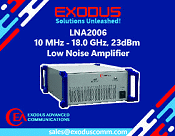 Exodus Advanced Communications, is a multinational
RF communication equipment and engineering service company serving both commercial
and government entities and their affiliates worldwide. We are pleased to offer
our
low-noise power amplifier for 10 MHz to 18.0 GHz. The LNA2006 produces
23 dBm (200 mW) power with 23 dB gain. A small class-A benchtop linear
design for optimum reliability & ruggedness for all EMC applications. Suitable
for all single channel modulation standards. Built-in protection circuits. Exodus Advanced Communications, is a multinational
RF communication equipment and engineering service company serving both commercial
and government entities and their affiliates worldwide. We are pleased to offer
our
low-noise power amplifier for 10 MHz to 18.0 GHz. The LNA2006 produces
23 dBm (200 mW) power with 23 dB gain. A small class-A benchtop linear
design for optimum reliability & ruggedness for all EMC applications. Suitable
for all single channel modulation standards. Built-in protection circuits.
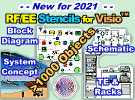 With more than 1000
custom-built stencils, this has got to be the most comprehensive set of
Visio Stencils available
for RF, analog, and digital system and schematic drawings! Every stencil symbol
has been built to fit proportionally on the included A-, B-, and C-size drawing
page templates (or use your own page if preferred). Components are provided for
system block diagrams, conceptual drawings, schematics, test equipment, racks, and
more. Page templates are provided with a preset scale (changeable) for a good presentation
that can incorporate all provided symbols... With more than 1000
custom-built stencils, this has got to be the most comprehensive set of
Visio Stencils available
for RF, analog, and digital system and schematic drawings! Every stencil symbol
has been built to fit proportionally on the included A-, B-, and C-size drawing
page templates (or use your own page if preferred). Components are provided for
system block diagrams, conceptual drawings, schematics, test equipment, racks, and
more. Page templates are provided with a preset scale (changeable) for a good presentation
that can incorporate all provided symbols...
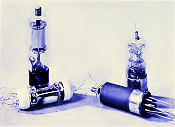 Who knew that the British General Post Office
was once in the vacuum tube development business? This 1957 article about the world's
first
transatlantic telephone line (TAT-1) mentions that the amplifier and frequency
equalizer repeater circuits and components for the Newfoundland and Nova Scotia
section of line was their responsibility. Bell Telephone Lab handled the deep-sea
portion of the system that ran between Newfoundland and Scotland. Everything was
designed to have at least a 20-year service-free lifespan. TAT-1 was inaugurated
September 25, 1956, and was decommissioned in 1978 without any technical failures
(although a trawler did snag the cable once, causing a brief outage), thus achieving
its designed longevity goal. An interesting solution was implemented to provide
the high voltage requirements of the equipment while avoiding excessive dielectric
thicknesses... Who knew that the British General Post Office
was once in the vacuum tube development business? This 1957 article about the world's
first
transatlantic telephone line (TAT-1) mentions that the amplifier and frequency
equalizer repeater circuits and components for the Newfoundland and Nova Scotia
section of line was their responsibility. Bell Telephone Lab handled the deep-sea
portion of the system that ran between Newfoundland and Scotland. Everything was
designed to have at least a 20-year service-free lifespan. TAT-1 was inaugurated
September 25, 1956, and was decommissioned in 1978 without any technical failures
(although a trawler did snag the cable once, causing a brief outage), thus achieving
its designed longevity goal. An interesting solution was implemented to provide
the high voltage requirements of the equipment while avoiding excessive dielectric
thicknesses...
 • Today
Is
World Amateur Radio Day • Today
Is
World Amateur Radio Day
• More
Small 5G Towers Reduce Network Energy Requirements
• FCC
to Online Retailers: Cease Selling Non-Secured IoT Devices
• How
AI Could Have Prevented the Key Bridge Collision
(or caused it)
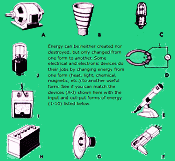 This quiz from a 1963 issue of Popular
Electronics magazine challenges (not too much, though) your knowledge of
energy conversion in common devices. A few of them might be unfamiliar to people
born after about 1990, but even so, you've probably seem them all at some point,
especially if you are a regular RF Cafe visitor (meaning you're probably smart).
It won't be giving anything away by telling you that item B is a heater that screws
into a light bulb socket, and item F is a phonograph stylus. Robert P. Balin
constructed many quizzes of this kind in the 1960s and 70s. A complete list of all
the Popular Electronics Quizzes is lower on this page... This quiz from a 1963 issue of Popular
Electronics magazine challenges (not too much, though) your knowledge of
energy conversion in common devices. A few of them might be unfamiliar to people
born after about 1990, but even so, you've probably seem them all at some point,
especially if you are a regular RF Cafe visitor (meaning you're probably smart).
It won't be giving anything away by telling you that item B is a heater that screws
into a light bulb socket, and item F is a phonograph stylus. Robert P. Balin
constructed many quizzes of this kind in the 1960s and 70s. A complete list of all
the Popular Electronics Quizzes is lower on this page...
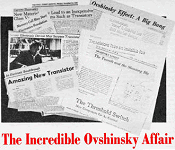 Even with having been granted more than
400 patents in his lifetime, and being a major player in the realms of energy, data
storage, and semiconductor research and manufacturing, you - as well as most people
- have probably never heard the name
Stanford Ovshinsky. He was somewhat of a celebrity in the 1960s and 1970s when
working hard to promote his concept of "glassy semiconductors," - aka Ovonic devices.
Ovonics are amorphous materials that are used for making switches for digital logic
and memory devices. Either the Ovshinsky process did not pan out for high volume
commercial production or some other technology displaced the what it was hoped to
dominate. Not too long ago when watching an episode of original The Man from U.N.C.L.E.
TV series, the Ovshinsky Effect was mentioned by Illya Kuryakin when watching it
after having read this article in a 1969 issue of Electronics Illustrated
magazine... Even with having been granted more than
400 patents in his lifetime, and being a major player in the realms of energy, data
storage, and semiconductor research and manufacturing, you - as well as most people
- have probably never heard the name
Stanford Ovshinsky. He was somewhat of a celebrity in the 1960s and 1970s when
working hard to promote his concept of "glassy semiconductors," - aka Ovonic devices.
Ovonics are amorphous materials that are used for making switches for digital logic
and memory devices. Either the Ovshinsky process did not pan out for high volume
commercial production or some other technology displaced the what it was hoped to
dominate. Not too long ago when watching an episode of original The Man from U.N.C.L.E.
TV series, the Ovshinsky Effect was mentioned by Illya Kuryakin when watching it
after having read this article in a 1969 issue of Electronics Illustrated
magazine...
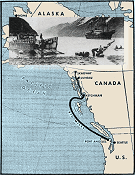 Alaska and Hawaii were added to the Union
as the 49th and 50th states, respectively, in 1959. Prior to that time, both were
referred to as possessions or territories. This story from a 1957 edition of
Radio & Television News refers to Bell Telephone Systems and the U.S. Army
Signal Corps laying the first cable for opening commercial telephone service between
Port Angeles (near Seattle), Washington, and Ketchikan, Territory of Alaska. The
900 mile, submarine cable carried 36 circuits, and took 2 years to install at
a cost of $20 million ($226 million in 2024 money per the BLS). Work conditions
for crews were nowhere near as accommodating or protected against accidents as they
are today. As with so many things, our forebears sacrificed life and limb, literally,
to bring us to the comfortable existence we enjoy today. The men in these and other
vintage photos I post deserve your gratitude... Alaska and Hawaii were added to the Union
as the 49th and 50th states, respectively, in 1959. Prior to that time, both were
referred to as possessions or territories. This story from a 1957 edition of
Radio & Television News refers to Bell Telephone Systems and the U.S. Army
Signal Corps laying the first cable for opening commercial telephone service between
Port Angeles (near Seattle), Washington, and Ketchikan, Territory of Alaska. The
900 mile, submarine cable carried 36 circuits, and took 2 years to install at
a cost of $20 million ($226 million in 2024 money per the BLS). Work conditions
for crews were nowhere near as accommodating or protected against accidents as they
are today. As with so many things, our forebears sacrificed life and limb, literally,
to bring us to the comfortable existence we enjoy today. The men in these and other
vintage photos I post deserve your gratitude...
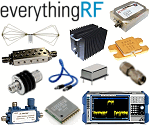 Please take a few moments to visit the
everythingRF website to see how they can assist you with your
project. everythingRF is a product discovery platform for RF and microwave products
and services. They currently have 267,269 products from more than 1397 companies
across 314 categories in their database and enable engineers to search for them
using their customized parametric search tool. Amplifiers, test equipment, power
couplers and dividers, coaxial connectors, waveguide, antennas, filters, mixers,
power supplies, and everything else. Please visit everythingRF today to see how
they can help you. Please take a few moments to visit the
everythingRF website to see how they can assist you with your
project. everythingRF is a product discovery platform for RF and microwave products
and services. They currently have 267,269 products from more than 1397 companies
across 314 categories in their database and enable engineers to search for them
using their customized parametric search tool. Amplifiers, test equipment, power
couplers and dividers, coaxial connectors, waveguide, antennas, filters, mixers,
power supplies, and everything else. Please visit everythingRF today to see how
they can help you.
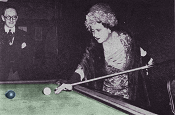 Pardon my self-indulgence here, but in this
world where every idiosyncrasy of every person and/or special interest group and/or
identity group must be accommodated - yea, even celebrated and accorded special
privileges - why is it that we
left-handers, south-paws, leftys, gawk-handers - call us what you may - to this
day are forced to adopt the practices and implements of right-handers? If a left-handed
version of a keyboard (number keys on left), a pair of scissors, notebooks with
hinging on the right, mugs with handle to the right of design, tape measures that
extend to the left with numbers right-side up, etc., it usually costs more. Speaking
of reparations (were we?), while many of the aforementioned entities are claiming
a right to reparations for past injustices regardless of whether the claimant ever
personally suffered from it, why shouldn't leftys, who historically have been forced
to adopt and adapt to the righty's world, and even punished for resistance or inability,
also now be financially compensated for the indignances? A few years ago I would
have asked for a cool million dollars, but with the
hyperinflation of late, I need $1.19M today. In cash, and tax-free... Pardon my self-indulgence here, but in this
world where every idiosyncrasy of every person and/or special interest group and/or
identity group must be accommodated - yea, even celebrated and accorded special
privileges - why is it that we
left-handers, south-paws, leftys, gawk-handers - call us what you may - to this
day are forced to adopt the practices and implements of right-handers? If a left-handed
version of a keyboard (number keys on left), a pair of scissors, notebooks with
hinging on the right, mugs with handle to the right of design, tape measures that
extend to the left with numbers right-side up, etc., it usually costs more. Speaking
of reparations (were we?), while many of the aforementioned entities are claiming
a right to reparations for past injustices regardless of whether the claimant ever
personally suffered from it, why shouldn't leftys, who historically have been forced
to adopt and adapt to the righty's world, and even punished for resistance or inability,
also now be financially compensated for the indignances? A few years ago I would
have asked for a cool million dollars, but with the
hyperinflation of late, I need $1.19M today. In cash, and tax-free...
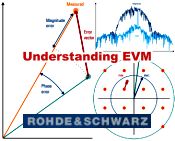 Rhode & Schwarz publishes a lot of very
useful application notes that are particularly for newcomers to the field of RF
and microwaves. All are forms of infomercials for their products, but than all companies
do it. This new one entitled, "Understanding
EVM," provides "...an introduction to error vector magnitude (EVM), which is
the primary metric of modulation accuracy. This paper is divided into three sections.
The first section discusses the fundamentals of the digital modulation schemes used
in modern radio frequency communications systems, in particular, APSK and QAM. The
second section discusses the fundamentals of error vector magnitude. This section
not only defines EVM, but also discusses the most common sources of EVM, how EVM
is measured, and the effects of EVM. The final section explains the basics of constellation
diagrams and how constellation diagrams can often be used to diagnose or troubleshoot
the common root causes of EVM. EVM is measured at each symbol time, and larger values
of EVM indicate greater distance between the measured and ideal points..." Rhode & Schwarz publishes a lot of very
useful application notes that are particularly for newcomers to the field of RF
and microwaves. All are forms of infomercials for their products, but than all companies
do it. This new one entitled, "Understanding
EVM," provides "...an introduction to error vector magnitude (EVM), which is
the primary metric of modulation accuracy. This paper is divided into three sections.
The first section discusses the fundamentals of the digital modulation schemes used
in modern radio frequency communications systems, in particular, APSK and QAM. The
second section discusses the fundamentals of error vector magnitude. This section
not only defines EVM, but also discusses the most common sources of EVM, how EVM
is measured, and the effects of EVM. The final section explains the basics of constellation
diagrams and how constellation diagrams can often be used to diagnose or troubleshoot
the common root causes of EVM. EVM is measured at each symbol time, and larger values
of EVM indicate greater distance between the measured and ideal points..."
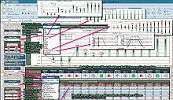 RF Cascade Workbook is the next phase in the evolution of RF Cafe's long-running
series, RF Cascade Workbook. Chances are you have never used a spreadsheet
quite like this (click
here for screen capture). It is a full-featured RF system cascade parameter
and frequency planner that includes filters and mixers for a mere $45. Built in
MS Excel, using RF Cascade Workbook is a cinch and the format
is entirely customizable. It is significantly easier and faster than using a multi-thousand
dollar simulator when a high level system analysis is all that is needed...
RF Cascade Workbook is the next phase in the evolution of RF Cafe's long-running
series, RF Cascade Workbook. Chances are you have never used a spreadsheet
quite like this (click
here for screen capture). It is a full-featured RF system cascade parameter
and frequency planner that includes filters and mixers for a mere $45. Built in
MS Excel, using RF Cascade Workbook is a cinch and the format
is entirely customizable. It is significantly easier and faster than using a multi-thousand
dollar simulator when a high level system analysis is all that is needed...
 "Research groups from NIMS, Seagate Technology,
and Tohoku University have made a breakthrough in the field of hard disk drives
(HDD) by demonstrating the feasibility of multi-level recording using a
three-dimensional magnetic recording medium to store digital information. The
research groups have shown that this technology can be used to increase the storage
capacity of HDDs, which could lead to more efficient and cost-effective data storage
solutions in the future. Enhancing Data Storage Capacity Data centers are increasingly
storing vast amounts of data on hard disk drives (HDDs) that use perpendicular magnetic
recording (PMR) to store information at areal densities of around 1.5 Tbit/in².
However, to transition to higher areal densities, a high anisotropy magnetic recording
medium consisting of FePt grains combined with heat-assisted laser writing is required.
This method, known as heat-assisted magnetic recording (HAMR), is capable of sustaining
areal recording densities of up to 10 Tbit/in². Furthermore, densities of larger
than 10 Tbit/in² are possible based on a new principle demonstrated by storing multiple
recording levels of 3 or 4 compared..." "Research groups from NIMS, Seagate Technology,
and Tohoku University have made a breakthrough in the field of hard disk drives
(HDD) by demonstrating the feasibility of multi-level recording using a
three-dimensional magnetic recording medium to store digital information. The
research groups have shown that this technology can be used to increase the storage
capacity of HDDs, which could lead to more efficient and cost-effective data storage
solutions in the future. Enhancing Data Storage Capacity Data centers are increasingly
storing vast amounts of data on hard disk drives (HDDs) that use perpendicular magnetic
recording (PMR) to store information at areal densities of around 1.5 Tbit/in².
However, to transition to higher areal densities, a high anisotropy magnetic recording
medium consisting of FePt grains combined with heat-assisted laser writing is required.
This method, known as heat-assisted magnetic recording (HAMR), is capable of sustaining
areal recording densities of up to 10 Tbit/in². Furthermore, densities of larger
than 10 Tbit/in² are possible based on a new principle demonstrated by storing multiple
recording levels of 3 or 4 compared..."
 RF Cafe visitor James G. sent me photos
of some paper capacitors he plans to replace in a 1950s vintage radio set. It is
a foreign job, most likely from France, based on the schematic. Some markings on
the capacitors are not familiar; maybe you have seen them. RF Cafe visitor James G. sent me photos
of some paper capacitors he plans to replace in a 1950s vintage radio set. It is
a foreign job, most likely from France, based on the schematic. Some markings on
the capacitors are not familiar; maybe you have seen them.
 The photos show things like "ESSAI 1.500
V.C.C." which I assume means 1,500 V (1.5 kV) working voltage, based on
the European swapping of dots and commas for decimal points. "Essai" in French means
"test," or "trial." "V.C.C." is probably a French marking for voltage similar to
WVDC (DC working voltage). Another marking shows "100/1000 de The photos show things like "ESSAI 1.500
V.C.C." which I assume means 1,500 V (1.5 kV) working voltage, based on
the European swapping of dots and commas for decimal points. "Essai" in French means
"test," or "trial." "V.C.C." is probably a French marking for voltage similar to
WVDC (DC working voltage). Another marking shows "100/1000 de F," which could be μμF,
but unlikely given it is a paper capacitor. Maybe millifarad? Any insight will be
appreciated. F," which could be μμF,
but unlikely given it is a paper capacitor. Maybe millifarad? Any insight will be
appreciated.
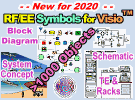 With more than 1000
custom-built symbols, this has got to be the most comprehensive set of
Visio Symbols available
for RF, analog, and digital system and schematic drawings! Every object has
been built to fit proportionally on the provided A-, B- and C-size drawing page
templates (or can use your own). Symbols are provided for equipment racks and test
equipment, system block diagrams, conceptual drawings, and schematics. Unlike previous
versions, these are NOT Stencils, but instead are all contained on tabbed pages
within a single Visio document. That puts everything in front of you in its full
glory. Just copy and paste what you need on your drawing... With more than 1000
custom-built symbols, this has got to be the most comprehensive set of
Visio Symbols available
for RF, analog, and digital system and schematic drawings! Every object has
been built to fit proportionally on the provided A-, B- and C-size drawing page
templates (or can use your own). Symbols are provided for equipment racks and test
equipment, system block diagrams, conceptual drawings, and schematics. Unlike previous
versions, these are NOT Stencils, but instead are all contained on tabbed pages
within a single Visio document. That puts everything in front of you in its full
glory. Just copy and paste what you need on your drawing...
 Here is a really good synopsis of
"rare earth" elements that explains how they came to be known in that way. Hint:
It is not that they are so rare, in fact per Wikipedia, Cerium is the 25th most
abundant element on Earth. The issue is they are not in concentrated lodes, but
spread out as components of other mineral compounds, so extensive processing is
needed to isolate and purify them. One of the first post-war commercial level extraction
processes was the result of experimentations during nuclear bomb research. As you
might know, "holes" existed in the Periodic Table of the Elements when it was first
constructed in 1869 by Dmitri Mendeleev, because not all predicted naturally occurring
elements had been found. Helium, atomic number 2, was not found on Earth until 1895,
after first having been observed in the sun's spectrum a few years earlier (hence
its name, from Helios). Author Alden Armagnac provides a primer in the original
15 rare earths (now 17) in this 1949 Popular Science magazine article... Here is a really good synopsis of
"rare earth" elements that explains how they came to be known in that way. Hint:
It is not that they are so rare, in fact per Wikipedia, Cerium is the 25th most
abundant element on Earth. The issue is they are not in concentrated lodes, but
spread out as components of other mineral compounds, so extensive processing is
needed to isolate and purify them. One of the first post-war commercial level extraction
processes was the result of experimentations during nuclear bomb research. As you
might know, "holes" existed in the Periodic Table of the Elements when it was first
constructed in 1869 by Dmitri Mendeleev, because not all predicted naturally occurring
elements had been found. Helium, atomic number 2, was not found on Earth until 1895,
after first having been observed in the sun's spectrum a few years earlier (hence
its name, from Helios). Author Alden Armagnac provides a primer in the original
15 rare earths (now 17) in this 1949 Popular Science magazine article...
|
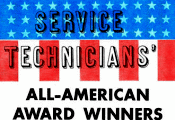 If you had a father, brother, uncle, grandfather,
husband, or neighbor who was an electronics service technician in the days of yore,
he might have been mentioned in this 1958 issue of Radio & TV News magazine
highlighting General Electric's
Service technicians' All-American Award Winner. Rather than rewarding the independent
businessmen for their technical prowess, the company assigned awards based on community
services performed, thereby reflecting positively on both GE and the electronics
service business as a whole. Each winner received a $500 check, which in 2024 money
is the equivalent to about $5,400 (per the BLS) in today's economy. The closest
thing we have to the radio and television serviceman today is maybe the guys who
install broadband cable and satellite dishes. Their level technical knowledge is
not required to be anywhere near as deep as their predecessors, though. Something
that always strikes me about photos from before about the 1960s is how sparsely... If you had a father, brother, uncle, grandfather,
husband, or neighbor who was an electronics service technician in the days of yore,
he might have been mentioned in this 1958 issue of Radio & TV News magazine
highlighting General Electric's
Service technicians' All-American Award Winner. Rather than rewarding the independent
businessmen for their technical prowess, the company assigned awards based on community
services performed, thereby reflecting positively on both GE and the electronics
service business as a whole. Each winner received a $500 check, which in 2024 money
is the equivalent to about $5,400 (per the BLS) in today's economy. The closest
thing we have to the radio and television serviceman today is maybe the guys who
install broadband cable and satellite dishes. Their level technical knowledge is
not required to be anywhere near as deep as their predecessors, though. Something
that always strikes me about photos from before about the 1960s is how sparsely...
 •
Hertz Loses Another $200M from EVs •
Hertz Loses Another $200M from EVs
• UK Government
Urged to Support 5G Rollouts
• Samsung
#1 in Q1 Smartphone Market
• Vodafone Idea Launches
$2.16B Share Sale
• Radio
Ink on a New Course
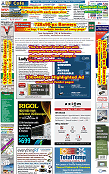 Banner Ads are rotated in all locations
on the page! RF Cafe typically receives 8,000-15,000 visits each
weekday. RF Cafe
is a favorite of engineers, technicians, hobbyists, and students all over the world.
With more than 17,000 pages in the Google search index, RF Cafe returns in
favorable positions on many types of key searches, both for text and images.
Your Banner Ads are displayed on average 280,000 times per year! New content
is added on a daily basis, which keeps the major search engines interested enough
to spider it multiple times each day. Items added on the homepage often can be found
in a Google search within a few hours of being posted. If you need your company
news to be seen, RF Cafe is the place to be... Banner Ads are rotated in all locations
on the page! RF Cafe typically receives 8,000-15,000 visits each
weekday. RF Cafe
is a favorite of engineers, technicians, hobbyists, and students all over the world.
With more than 17,000 pages in the Google search index, RF Cafe returns in
favorable positions on many types of key searches, both for text and images.
Your Banner Ads are displayed on average 280,000 times per year! New content
is added on a daily basis, which keeps the major search engines interested enough
to spider it multiple times each day. Items added on the homepage often can be found
in a Google search within a few hours of being posted. If you need your company
news to be seen, RF Cafe is the place to be...
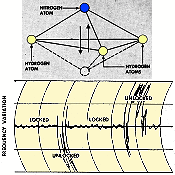 This report on America's first operational
atomic
clock appeared in a 1949 issue of Popular Science magazine. The National
Bureau of Standards (NBS), now called the National Institute of Standards and Technology
(NIST), built an ammonia-based atomic clock which achieved the then unheard of uncertainty
of plus or minus one second every 300 years. NIST's current atomic clock (NIST-F2)
boasts an uncertainty of one second every 300 million years. It uses caesium-133
as a reference. Other factors enabling the greater accuracy is a more stable enclosure,
high precision laser measurement, and cooling closer to absolute zero. Of course
if the atom ever did reach absolute zero, it would stop vibrating and not be of
much use - other than maybe as a direct current (DC) reference ;- This report on America's first operational
atomic
clock appeared in a 1949 issue of Popular Science magazine. The National
Bureau of Standards (NBS), now called the National Institute of Standards and Technology
(NIST), built an ammonia-based atomic clock which achieved the then unheard of uncertainty
of plus or minus one second every 300 years. NIST's current atomic clock (NIST-F2)
boasts an uncertainty of one second every 300 million years. It uses caesium-133
as a reference. Other factors enabling the greater accuracy is a more stable enclosure,
high precision laser measurement, and cooling closer to absolute zero. Of course
if the atom ever did reach absolute zero, it would stop vibrating and not be of
much use - other than maybe as a direct current (DC) reference ;-
 Sam Benzacar, of Anatech Electronics, an
RF and microwave filter company, has published his April 2024 newsletter that, along
with timely news items, features his short op−ed entitled "Expanding
IoT Networks Pose Increased Security Risk," where he reports on the current
state of 5G and the Internet of Things (IoT) world. He says there are 20 million
IoT devices in service now and an expected 27 million by 2025 (that's next year,
believe it or not!). The movement from wired to wireless began with Bluetooth, WiFi,
cellular, and even ZigBee to some extent. 5G's stated goal is to have the capability
to totally obviate the need for wired interconnections, be it for telephones, computers,
security, home appliances, industrial controls, or any other entity needing real-time
communications with something else. Of course most equipment requires a separate
power supply from batteries (with or without dedicated solar cell array, wind generator,
etc.) or the electric power distribution system. Along with the freedom from wires
comes subjection to malicious infiltration to collect data and/or to control the
device or system. It is an unfortunate fact that there is always someone or some
group intent of corrupting and harming others... Sam Benzacar, of Anatech Electronics, an
RF and microwave filter company, has published his April 2024 newsletter that, along
with timely news items, features his short op−ed entitled "Expanding
IoT Networks Pose Increased Security Risk," where he reports on the current
state of 5G and the Internet of Things (IoT) world. He says there are 20 million
IoT devices in service now and an expected 27 million by 2025 (that's next year,
believe it or not!). The movement from wired to wireless began with Bluetooth, WiFi,
cellular, and even ZigBee to some extent. 5G's stated goal is to have the capability
to totally obviate the need for wired interconnections, be it for telephones, computers,
security, home appliances, industrial controls, or any other entity needing real-time
communications with something else. Of course most equipment requires a separate
power supply from batteries (with or without dedicated solar cell array, wind generator,
etc.) or the electric power distribution system. Along with the freedom from wires
comes subjection to malicious infiltration to collect data and/or to control the
device or system. It is an unfortunate fact that there is always someone or some
group intent of corrupting and harming others...
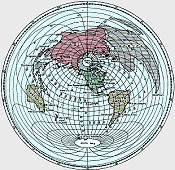 Before the Internet, cellphone apps, and
personal computers, many calculations began with a lookup table, chart, or nomograph.
In the case of long distance radio operators [Ham,
Short Wave Listener (SWL), and professional types] seeking distance and direction
information for pointing antennas, it took a map like this one published by Radio
News & Short-Wave magazine in 1934 to estimate an optimal configuration. Such
tools were essential in order to determine the best direction to point the antenna,
which over a long distance is usually much different than what might be assumed
by looking at a flattened projection map of the earth (see "Distance Lends Enchantment"
below). Distances in Chart No. 1 are all relative to New York, so operators
in other locales need to compensate... Before the Internet, cellphone apps, and
personal computers, many calculations began with a lookup table, chart, or nomograph.
In the case of long distance radio operators [Ham,
Short Wave Listener (SWL), and professional types] seeking distance and direction
information for pointing antennas, it took a map like this one published by Radio
News & Short-Wave magazine in 1934 to estimate an optimal configuration. Such
tools were essential in order to determine the best direction to point the antenna,
which over a long distance is usually much different than what might be assumed
by looking at a flattened projection map of the earth (see "Distance Lends Enchantment"
below). Distances in Chart No. 1 are all relative to New York, so operators
in other locales need to compensate...
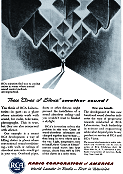 When most people of my era (born 1958) see
or hear something about a
Cone of Silence, they immediately think of the old Get Smart sitcom that ran
in the middle through late 1960s (we have the DVD set). Don Adams, aka Maxwell Smart,
aka Agent 86, and Barbara Feldon, aka Agent 99 (no name actually used),
were the top operatives within the good-guy international crime fighting organizations
known as CONTROL*. Their arch enemy was KAOS*. One of the gags used in the show
was the Cone of Silence, meant to ensure a conversation between two CONTROL agents
would not he heard by anyone else. The problem was that it never worked properly
and the people ended up yelling to each other and/or holding up handwritten notes
- both of which negated the need for a Cone of Silence. The users were most often
Max and The Chief. The Get Smart series was a spoof of James Bond and The Pink Panther... When most people of my era (born 1958) see
or hear something about a
Cone of Silence, they immediately think of the old Get Smart sitcom that ran
in the middle through late 1960s (we have the DVD set). Don Adams, aka Maxwell Smart,
aka Agent 86, and Barbara Feldon, aka Agent 99 (no name actually used),
were the top operatives within the good-guy international crime fighting organizations
known as CONTROL*. Their arch enemy was KAOS*. One of the gags used in the show
was the Cone of Silence, meant to ensure a conversation between two CONTROL agents
would not he heard by anyone else. The problem was that it never worked properly
and the people ended up yelling to each other and/or holding up handwritten notes
- both of which negated the need for a Cone of Silence. The users were most often
Max and The Chief. The Get Smart series was a spoof of James Bond and The Pink Panther...
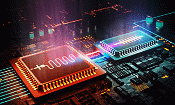 "Chasing ever-higher qubit counts in near-term
quantum computers constantly demands new feats of engineering. Among the troublesome
hurdles of this scaling-up race is refining how qubits are measured. Devices called
parametric amplifiers are traditionally used to do these measurements. But as the
name suggests, the device amplifies weak signals picked up from the qubits to conduct
the readout, which causes unwanted noise and can lead to
decoherence of the qubits if not protected by additional large components. More
importantly, the bulky size of the amplification chain becomes technically challenging
to work around as qubit counts increase in size-limited refrigerators. Bolometer-Based
Qubit Measurement Cue the Aalto University research group Quantum Computing and
Devices (QCD). They have a hefty track record of showing how thermal bolometers
can be used as ultrasensitive detectors, and they just demonstrated..." "Chasing ever-higher qubit counts in near-term
quantum computers constantly demands new feats of engineering. Among the troublesome
hurdles of this scaling-up race is refining how qubits are measured. Devices called
parametric amplifiers are traditionally used to do these measurements. But as the
name suggests, the device amplifies weak signals picked up from the qubits to conduct
the readout, which causes unwanted noise and can lead to
decoherence of the qubits if not protected by additional large components. More
importantly, the bulky size of the amplification chain becomes technically challenging
to work around as qubit counts increase in size-limited refrigerators. Bolometer-Based
Qubit Measurement Cue the Aalto University research group Quantum Computing and
Devices (QCD). They have a hefty track record of showing how thermal bolometers
can be used as ultrasensitive detectors, and they just demonstrated..."
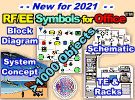 It was a lot of work, but I finally finished
a version of the "RF &
Electronics Schematic & Block Diagram Symbols"" that works well with Microsoft
Office™ programs Word™, Excel™, and Power Point™. This is an equivalent of the extensive
set of amplifier, mixer, filter, switch, connector, waveguide, digital, analog,
antenna, and other commonly used symbols for system block diagrams and schematics
created for Visio™. Each of the 1,000+ symbols was exported individually from Visio
in the EMF file format, then imported into Word on a Drawing Canvas. The EMF format
allows an image to be scaled up or down without becoming pixelated, so all the shapes
can be resized in a document and still look good. The imported symbols can also
be UnGrouped into their original constituent parts for editing... It was a lot of work, but I finally finished
a version of the "RF &
Electronics Schematic & Block Diagram Symbols"" that works well with Microsoft
Office™ programs Word™, Excel™, and Power Point™. This is an equivalent of the extensive
set of amplifier, mixer, filter, switch, connector, waveguide, digital, analog,
antenna, and other commonly used symbols for system block diagrams and schematics
created for Visio™. Each of the 1,000+ symbols was exported individually from Visio
in the EMF file format, then imported into Word on a Drawing Canvas. The EMF format
allows an image to be scaled up or down without becoming pixelated, so all the shapes
can be resized in a document and still look good. The imported symbols can also
be UnGrouped into their original constituent parts for editing...
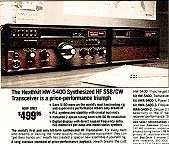 This good bit of personal insight into the
Heathkit HW−5400 high frequency transceiver for Ham radio was offered by website
visitor Paul A., of Long Island, New York. Lots of Heathkit builders made modifications,
some necessary to achieve advertised performance, and others for improved performance.
Paul's efforts are quite impressive. I made the comment that since Heathkit products
were not built and tested in-house in large volumes, they did not have the benefit
of feedback on performance of systems and components that would otherwise be gained
from a production line. Prior to making new products available, Heathkit designers
had a number of fellow employees build the kits at home using parts and instructions
intended for customers. Changes were made based on that information, but that is
nowhere near the quality of feedback provided on an assembly line. He begins: "Back
in November of 2023 you had an article about the Heathkit HW5400. It included some
photos of an unbuilt kit. This brought back many memories. I'm the original owner
of an HW5400 that I purchased in 1985 from the Heathkit store in Northern Virginia.
I bought the transceiver, speaker/power supply, keypad and the accessory IF filter.
I had no idea what was in store for me! The transceiver worked the first time I
turned it on, but after putting it on the air, I began to get reports of distorted
or unnatural transmit audio. Thus began a two year long project to fix the bad audio..." This good bit of personal insight into the
Heathkit HW−5400 high frequency transceiver for Ham radio was offered by website
visitor Paul A., of Long Island, New York. Lots of Heathkit builders made modifications,
some necessary to achieve advertised performance, and others for improved performance.
Paul's efforts are quite impressive. I made the comment that since Heathkit products
were not built and tested in-house in large volumes, they did not have the benefit
of feedback on performance of systems and components that would otherwise be gained
from a production line. Prior to making new products available, Heathkit designers
had a number of fellow employees build the kits at home using parts and instructions
intended for customers. Changes were made based on that information, but that is
nowhere near the quality of feedback provided on an assembly line. He begins: "Back
in November of 2023 you had an article about the Heathkit HW5400. It included some
photos of an unbuilt kit. This brought back many memories. I'm the original owner
of an HW5400 that I purchased in 1985 from the Heathkit store in Northern Virginia.
I bought the transceiver, speaker/power supply, keypad and the accessory IF filter.
I had no idea what was in store for me! The transceiver worked the first time I
turned it on, but after putting it on the air, I began to get reports of distorted
or unnatural transmit audio. Thus began a two year long project to fix the bad audio..."
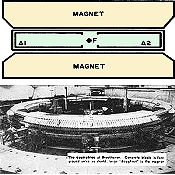 By 1957, when this article appeared in
Popular Electronics magazine,
betatrons, cyclotrons, cosmotrons, synchrocyclotron, bevatrons, and other forms
of "trons" had the physics world all agog with anticipation of the next big discovery.
Quarks were still a decade away from being discovered and something as exotic as
the Higgs boson (aka god particle) hadn't entered anyone's mind. The news media
was agog with reports of the world possibly coming to the end as a result of those
experiments sparking a nuclear reaction chain that would cause the whole world to
explode. Today, the news media is no smarter, because nowadays they fret over the
Large Hadron Collider (LHC) generating a black hole that will implode the whole
world. What a ship of fools... By 1957, when this article appeared in
Popular Electronics magazine,
betatrons, cyclotrons, cosmotrons, synchrocyclotron, bevatrons, and other forms
of "trons" had the physics world all agog with anticipation of the next big discovery.
Quarks were still a decade away from being discovered and something as exotic as
the Higgs boson (aka god particle) hadn't entered anyone's mind. The news media
was agog with reports of the world possibly coming to the end as a result of those
experiments sparking a nuclear reaction chain that would cause the whole world to
explode. Today, the news media is no smarter, because nowadays they fret over the
Large Hadron Collider (LHC) generating a black hole that will implode the whole
world. What a ship of fools...
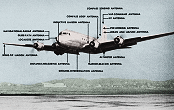 1949 wasn't all that long of a time since
airplane antennas consisted of a hundred feet or more of wire that was spooled
out in the air to trail behind the craft, servicing a CW type radio. The pilot tapped
out Morse code on a key strapped to his knee and wrote down the received code as
it came in. Prior to landing, the pilot wound the trailing wire antenna back in
- which sometimes was forgotten and got ripped off by trees. By the time World War II
came around, operating frequencies had moved up in the electromagnetic (EM) spectrum
and antennas were accordingly shortened. Still, a review of airplanes at the time
showed wire antennas strung from somewhere in the forward region of the airplane
(over or under the cockpit) or from the wingtip(s), back to the tip of the vertical
fin or tip of the horizontal stabilizer. That was all OK when airspeeds were south
of 200 mph or so, but higher speeds caused excessive drag in the air requiring
more rugged components, which added to weight. An exposed antenna also was subject
to risk of damage from ice, strikes by foreign objects, and oscillation. This
Popular Science article reports on some of the many advances made in embedding
antennas... 1949 wasn't all that long of a time since
airplane antennas consisted of a hundred feet or more of wire that was spooled
out in the air to trail behind the craft, servicing a CW type radio. The pilot tapped
out Morse code on a key strapped to his knee and wrote down the received code as
it came in. Prior to landing, the pilot wound the trailing wire antenna back in
- which sometimes was forgotten and got ripped off by trees. By the time World War II
came around, operating frequencies had moved up in the electromagnetic (EM) spectrum
and antennas were accordingly shortened. Still, a review of airplanes at the time
showed wire antennas strung from somewhere in the forward region of the airplane
(over or under the cockpit) or from the wingtip(s), back to the tip of the vertical
fin or tip of the horizontal stabilizer. That was all OK when airspeeds were south
of 200 mph or so, but higher speeds caused excessive drag in the air requiring
more rugged components, which added to weight. An exposed antenna also was subject
to risk of damage from ice, strikes by foreign objects, and oscillation. This
Popular Science article reports on some of the many advances made in embedding
antennas...
 Werbel Microwave, one of the world's premier
RF and microwave components manufacturer, is proud to introduce the WM9RD-7.2-S,
a
9-way resistive power splitter / combiner that covers DC to 7.2 GHz with
ultra-wide bandwidth. This unique design accomplishes extremely flat frequency response
in a small radial package. Our unique design approach provides higher than expected
isolation between outputs at far ports than would be achieved in a typical star
topology (>28 dB between Groups A-B-C, see datasheet). It has applications
in markets such as CATV, test and measurement, and military radio. Its small size
makes it easy to integrate into compact systems. Designed, assembled, and tested
in the USA... Werbel Microwave, one of the world's premier
RF and microwave components manufacturer, is proud to introduce the WM9RD-7.2-S,
a
9-way resistive power splitter / combiner that covers DC to 7.2 GHz with
ultra-wide bandwidth. This unique design accomplishes extremely flat frequency response
in a small radial package. Our unique design approach provides higher than expected
isolation between outputs at far ports than would be achieved in a typical star
topology (>28 dB between Groups A-B-C, see datasheet). It has applications
in markets such as CATV, test and measurement, and military radio. Its small size
makes it easy to integrate into compact systems. Designed, assembled, and tested
in the USA...
 RF Cascade Workbook is the next phase in the evolution of RF Cafe's long-running
series, RF Cascade Workbook. Chances are you have never used a spreadsheet
quite like this (click
here for screen capture). It is a full-featured RF system cascade parameter
and frequency planner that includes filters and mixers for a mere $45. Built in
MS Excel, using RF Cascade Workbook is a cinch and the format
is entirely customizable. It is significantly easier and faster than using a multi-thousand
dollar simulator when a high level system analysis is all that is needed...
RF Cascade Workbook is the next phase in the evolution of RF Cafe's long-running
series, RF Cascade Workbook. Chances are you have never used a spreadsheet
quite like this (click
here for screen capture). It is a full-featured RF system cascade parameter
and frequency planner that includes filters and mixers for a mere $45. Built in
MS Excel, using RF Cascade Workbook is a cinch and the format
is entirely customizable. It is significantly easier and faster than using a multi-thousand
dollar simulator when a high level system analysis is all that is needed...
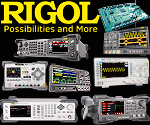 RIGOL Technologies is transforming the Test
and Measurement Industry. Our premium line of products includes digital and mixed
signal oscilloscopes, spectrum analyzers, function / arbitrary waveform generators,
programmable power supplies and loads, digital multimeters, data acquisition systems,
and application software. Our test solutions combine uncompromised product performance,
quality, and advanced product features; all delivered at extremely attractive price
points. This combination provides our customers with unprecedented value for their
investment, reduces their overall cost of test, and helps speed time to completion
of their designs or projects. RIGOL Technologies is transforming the Test
and Measurement Industry. Our premium line of products includes digital and mixed
signal oscilloscopes, spectrum analyzers, function / arbitrary waveform generators,
programmable power supplies and loads, digital multimeters, data acquisition systems,
and application software. Our test solutions combine uncompromised product performance,
quality, and advanced product features; all delivered at extremely attractive price
points. This combination provides our customers with unprecedented value for their
investment, reduces their overall cost of test, and helps speed time to completion
of their designs or projects.
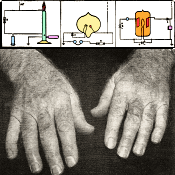 The price of fame and fortune is often fraught
with great tribulations and trials - literally. This eulogy of Audio vacuum tube
inventor
Lee de Forest which was written in 1961 by Radio-Electronics magazine
editor Hugo Gernsback, summarizes many of the great accomplishments of the inventor
/ engineer, but does not mention the battles he fought both to protect his work
from misappropriation by others and to defend himself from accusations of the same.
All the industry greats - Edison, Armstrong, Tesla, Westinghouse, Noyce, Sarnoff,
even Einstein - suffered similar experiences. Mr. Gernsback, a prolific inventor
and publisher himself - was a good personal friend of Dr. de Forest, and
featured his work often over more than three decades through his (Gernsback's) many
trade magazines. A list of many of the articles is at the bottom of this page. If
you are not familiar with the story of how de Forest arrived at his amplifying
Audion tube, please read "How the Audion Was Invented. The journey began with the
use of an open candle flame as a signal detector for CW (continuous wave) signals
in wireless telegraphy. Interestingly, Mr. Gernsback deemed having a close-up photo
of Dr. de Forest's hands was in important piece of the historical record... The price of fame and fortune is often fraught
with great tribulations and trials - literally. This eulogy of Audio vacuum tube
inventor
Lee de Forest which was written in 1961 by Radio-Electronics magazine
editor Hugo Gernsback, summarizes many of the great accomplishments of the inventor
/ engineer, but does not mention the battles he fought both to protect his work
from misappropriation by others and to defend himself from accusations of the same.
All the industry greats - Edison, Armstrong, Tesla, Westinghouse, Noyce, Sarnoff,
even Einstein - suffered similar experiences. Mr. Gernsback, a prolific inventor
and publisher himself - was a good personal friend of Dr. de Forest, and
featured his work often over more than three decades through his (Gernsback's) many
trade magazines. A list of many of the articles is at the bottom of this page. If
you are not familiar with the story of how de Forest arrived at his amplifying
Audion tube, please read "How the Audion Was Invented. The journey began with the
use of an open candle flame as a signal detector for CW (continuous wave) signals
in wireless telegraphy. Interestingly, Mr. Gernsback deemed having a close-up photo
of Dr. de Forest's hands was in important piece of the historical record...
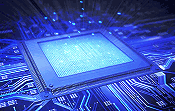 Ruh-roh, here is another science news item
sure to memristor denier and über nimrod Tim H.,
who for years sent me harassing e-mails to inform me of how memristors are only
theoretical entities. He got downright abusive and threatening. Maybe someday I'll
reveal his identity ... but I digress. This article from the SciTechDaily website
reports on work done at the University of Southern California. It begins: "Researchers
have made
significant advances in memristor technology, enhancing its precision and efficiency.
This innovation promises to bridge the gap between analog and digital computing,
offering faster, more energy-efficient processing suitable for AI, machine learning,
and beyond..." Ruh-roh, here is another science news item
sure to memristor denier and über nimrod Tim H.,
who for years sent me harassing e-mails to inform me of how memristors are only
theoretical entities. He got downright abusive and threatening. Maybe someday I'll
reveal his identity ... but I digress. This article from the SciTechDaily website
reports on work done at the University of Southern California. It begins: "Researchers
have made
significant advances in memristor technology, enhancing its precision and efficiency.
This innovation promises to bridge the gap between analog and digital computing,
offering faster, more energy-efficient processing suitable for AI, machine learning,
and beyond..."
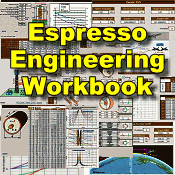 The newest release of RF Cafe's spreadsheet
(Excel) based engineering and science calculator is now available -
Espresso
Engineering Workbook™. Among other additions, it now has a Butterworth Bandpass
Calculator, and a Highpass Filter Calculator that does not just gain, but also
phase and group delay! Since 2002, the
original Calculator Workbook has been available as a free download. Continuing
the tradition, RF Cafe Espresso Engineering Workbook™ is also
provided at no cost,
compliments of my generous sponsors. The original calculators are included, but
with a vastly expanded and improved user interface. Error-trapped user input cells
help prevent entry of invalid values. An extensive use of Visual Basic for Applications
(VBA) functions now do most of the heavy lifting with calculations, and facilitates
a wide user-selectable choice of units for voltage, frequency, speed, temperature,
power, wavelength, weight, etc. In fact, a full page of units conversion calculators
is included. A particularly handy feature is the ability to specify the the number
of significant digits to display. Drop-down menus are provided for convenience... The newest release of RF Cafe's spreadsheet
(Excel) based engineering and science calculator is now available -
Espresso
Engineering Workbook™. Among other additions, it now has a Butterworth Bandpass
Calculator, and a Highpass Filter Calculator that does not just gain, but also
phase and group delay! Since 2002, the
original Calculator Workbook has been available as a free download. Continuing
the tradition, RF Cafe Espresso Engineering Workbook™ is also
provided at no cost,
compliments of my generous sponsors. The original calculators are included, but
with a vastly expanded and improved user interface. Error-trapped user input cells
help prevent entry of invalid values. An extensive use of Visual Basic for Applications
(VBA) functions now do most of the heavy lifting with calculations, and facilitates
a wide user-selectable choice of units for voltage, frequency, speed, temperature,
power, wavelength, weight, etc. In fact, a full page of units conversion calculators
is included. A particularly handy feature is the ability to specify the the number
of significant digits to display. Drop-down menus are provided for convenience...
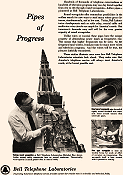 According to this full-page advertisement
in the June 1955 issue of Radio & Television News magazine, Bell Telephone
Laboratories was responsible for designing and fielding "waveguide
pipe," aka flexible circular waveguides. According to other historical sources,
both George Southworth of Bell Telephone Laboratories and Wilmer Barrow of the Massachusetts
Institute of Technology (M.I.T.) independently and simultaneously developed circular
waveguide, but the early devices were rigid pipe rather than being fabricated from
tightly wrapped, insulated wire that permitted it to be bent rather than requiring
separate corner and offset pieces. Insertion loss and VSWR is typically not as good
as with rigid waveguide, but the ease of installation in many situations justifies
the poorer electrical performance. Bell Telephone Laboratories was responsible for
a huge number of breakthrough and paradigm-changing discoveries prior to being broken
into parts (Regional Bell Operating Companies, aka Baby Bells) in 1984 due to an
antitrust lawsuit... According to this full-page advertisement
in the June 1955 issue of Radio & Television News magazine, Bell Telephone
Laboratories was responsible for designing and fielding "waveguide
pipe," aka flexible circular waveguides. According to other historical sources,
both George Southworth of Bell Telephone Laboratories and Wilmer Barrow of the Massachusetts
Institute of Technology (M.I.T.) independently and simultaneously developed circular
waveguide, but the early devices were rigid pipe rather than being fabricated from
tightly wrapped, insulated wire that permitted it to be bent rather than requiring
separate corner and offset pieces. Insertion loss and VSWR is typically not as good
as with rigid waveguide, but the ease of installation in many situations justifies
the poorer electrical performance. Bell Telephone Laboratories was responsible for
a huge number of breakthrough and paradigm-changing discoveries prior to being broken
into parts (Regional Bell Operating Companies, aka Baby Bells) in 1984 due to an
antitrust lawsuit...
 In 1958 when this "Customer Cues" installment
of John T. Frye's "Mac's
Service Shop" series of technodramas in Radio & TV News magazine, color
television was a relatively new phenomenon. The first commercially sold color TV
set - the Admiral C1617A - went on sale at the very end of 1953. The NTSC approved
the first standardized specification for a composite color television composite
signal (color, gray scale, audio, brightness, synchronization) earlier that year.
It allowed the same signal to work with both black and white (B&W) and color
receivers. A lot of research went into making sure the viewing public was happy
with their sets, using polls, hands-on instruction and publications on how to properly
adjust tuning and picture controls, plus tips on installing outdoor antennas and
running the twin lead transmission cable down to the set. Of course the proper way
to fiddle with the built-in "rabbit ears" antenna was covered as well. I don't think
any official pamphlets included mashing tinfoil onto the rabbit ears in complex
patterns as many people did - truth is, it must have worked in some cases. In the
story, Mac schools Barney on the situation. In 1958 when this "Customer Cues" installment
of John T. Frye's "Mac's
Service Shop" series of technodramas in Radio & TV News magazine, color
television was a relatively new phenomenon. The first commercially sold color TV
set - the Admiral C1617A - went on sale at the very end of 1953. The NTSC approved
the first standardized specification for a composite color television composite
signal (color, gray scale, audio, brightness, synchronization) earlier that year.
It allowed the same signal to work with both black and white (B&W) and color
receivers. A lot of research went into making sure the viewing public was happy
with their sets, using polls, hands-on instruction and publications on how to properly
adjust tuning and picture controls, plus tips on installing outdoor antennas and
running the twin lead transmission cable down to the set. Of course the proper way
to fiddle with the built-in "rabbit ears" antenna was covered as well. I don't think
any official pamphlets included mashing tinfoil onto the rabbit ears in complex
patterns as many people did - truth is, it must have worked in some cases. In the
story, Mac schools Barney on the situation.
 Mystery stories were broadcast on radio
stations in the days before television - and for quite a while after TV was available
for that matter. Families gathered around the living room radio set in excited anticipation
of the next adventure of shows like "The Shadow," "Amos 'n' Andy," "Tales of the
Texas Rangers," "Dragnet," and "The Green Hornet." During that era, it was common
also for electronics magazines, which focused largely on radio communications, to
experiment with printed
dramas
that had a radio-centric theme. Here is the first of a series tried by Radio-Craft
magazine in the late 1930s. A couple decades later the "Carl & Jerry" adventures
were run in Popular Electronics, but other than that I don't recall seeing
a lot of these things. If you're a mystery fan, then here you go. A great collection
of old time radio broadcasts can be heard on the Old Radio World and Old Radio Programs
websites... Mystery stories were broadcast on radio
stations in the days before television - and for quite a while after TV was available
for that matter. Families gathered around the living room radio set in excited anticipation
of the next adventure of shows like "The Shadow," "Amos 'n' Andy," "Tales of the
Texas Rangers," "Dragnet," and "The Green Hornet." During that era, it was common
also for electronics magazines, which focused largely on radio communications, to
experiment with printed
dramas
that had a radio-centric theme. Here is the first of a series tried by Radio-Craft
magazine in the late 1930s. A couple decades later the "Carl & Jerry" adventures
were run in Popular Electronics, but other than that I don't recall seeing
a lot of these things. If you're a mystery fan, then here you go. A great collection
of old time radio broadcasts can be heard on the Old Radio World and Old Radio Programs
websites...
 Moral standards seem to rigidly obey the
second law of thermodynamics, which states that entropy (disorder) increases in
a closed system. Most people would say society is more rude and corrupt today than
in days gone by - count me among them. However, believing so does not obviate or
excuse acts of deviance in the past. Indeed, even esteemed organizations like the
American
Radio Relay League (ARRL) seems to have been guilty of promoting dishonest acts.
To wit, consider this offer appearing in the "Strayed" column of the April 1933
issue of QST magazine, "For Sale: QSL Cards of any country. Win your WAC
without delay. Name your spot. We'll send the card." It also describes a scheme
for ripping off electronics supplies stores. Shameful! Moral standards seem to rigidly obey the
second law of thermodynamics, which states that entropy (disorder) increases in
a closed system. Most people would say society is more rude and corrupt today than
in days gone by - count me among them. However, believing so does not obviate or
excuse acts of deviance in the past. Indeed, even esteemed organizations like the
American
Radio Relay League (ARRL) seems to have been guilty of promoting dishonest acts.
To wit, consider this offer appearing in the "Strayed" column of the April 1933
issue of QST magazine, "For Sale: QSL Cards of any country. Win your WAC
without delay. Name your spot. We'll send the card." It also describes a scheme
for ripping off electronics supplies stores. Shameful!
 Temwell is a manufacturer of 5G wireless communications filters
for aerospace, satellite communication, AIoT, 5G networking, IoV, drone, mining
transmission, IoT, medical, military, laboratory, transportation, energy, broadcasting
(CATV), and etc. An RF helical bandpass specialist since 1994, we have posted >5,000
completed spec sheets online for all kinds of RF filters including helical, cavity,
LC, and SMD. Standard highpass, lowpass, bandpass, and bandstop, as well as duplexer/diplexer,
multiplexer. Also RF combiners, splitters, power dividers, attenuators, circulators,
couplers, PA, LNA, and obsolete coil & inductor solutions. Temwell is a manufacturer of 5G wireless communications filters
for aerospace, satellite communication, AIoT, 5G networking, IoV, drone, mining
transmission, IoT, medical, military, laboratory, transportation, energy, broadcasting
(CATV), and etc. An RF helical bandpass specialist since 1994, we have posted >5,000
completed spec sheets online for all kinds of RF filters including helical, cavity,
LC, and SMD. Standard highpass, lowpass, bandpass, and bandstop, as well as duplexer/diplexer,
multiplexer. Also RF combiners, splitters, power dividers, attenuators, circulators,
couplers, PA, LNA, and obsolete coil & inductor solutions.
|